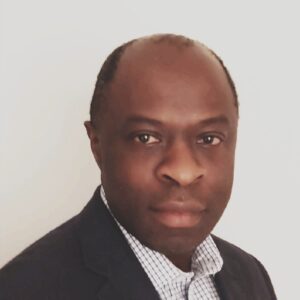
By EDI Committee member Kehinde Ross
Kehinde Ross is a Reader in Molecular and Cellular Biology at Liverpool John Moores University (LJMU). He earned his PhD from the University of Sheffield, where he studied cytokine signalling proteins associated with inflammatory diseases. He then completed postdoctoral training at Newcastle University, studying signal transduction associated with inflammatory skin disorders, prior to starting independent research related to microRNA (miRNA) expression and function.
His initial focus on skin has expanded to include studies of miRNA modulation in cancer, given that dysregulation of miRNA has been linked to various aspects of the disease. His current focus is the development of interdisciplinary collaborations to support the generation of nanocarriers for miRNA-directed therapy in cancer and other conditions.
Kehinde leads the Transformative Peptide Chemistry for RNA Nanotherapies Thematic Doctoral Pathway program at LJMU, one of the inaugural cohort-based PhD training schemes in the university. Additionally, he co-leads the LJMU Institute for Health Research Diagnostics and Therapeutics group, chairs the Diversity, Equity, and Inclusion committee of the RNA Society and is the post-1992 University representative on the Physiological Society EDI Committee.
As part of our Faces of Physiology Series, we spoke to Dr Kehinde Ross to learn more about the challenges he has faced and why EDI is important to him.
What challenges have you overcome to get to where you are?
Childhood poverty. We moved house seven times over a ten-year period during my primary and secondary school years, and most of those were because we could not pay the rent. If I subsequently felt out of place on the odd occasion during my PhD and postdoctoral years, it was not because I was Black but rather because I had come from a disadvantaged background, with all the anxiety and negative internal monologues associated with that. Thankfully things got better, and it is gratifying to see “socio-economic minorities” emerge as an inclusion category that is gaining increasing attention across the learned society and funding agency landscapes.
Why is EDI important to you, and what motivated you to get involved?
The murder of George Floyd in 2020 was a catalyst for change for companies, universities and indeed learned associations like the Physiological Society. I distinctly remember an online meeting where the then President of the Physiological Society pointed out that about 70% of physiology data is based on the White male, hence the need to mobilise resources to improve participation of under-represented groups in physiological sciences. Further, whilst often pursued with the best of intentions, some reactive EDI measures – tearing down statues and changing street names or even unconscious bias training – do little to improve outcomes for the disempowered child growing up in poverty anywhere in the world. Whereas schemes like the Physiological Society’s EDI Fund provide opportunities to develop tractable interventions with measurable long-term impacts that open up opportunities for physiological excellence to reach the many not the few.
What are your hopes for the future of the physiology community?
These are exciting times to be alive! With the seismic epistemological revolution happening through artificial intelligence, now more than ever we need the Physiological Society and other learned institutions to prioritise people-centred initiatives to foster innovation, creativity, economic growth and shared prosperity. This will require a re-imagining of how we work to increase membership, create opportunities for knowledge exchange and influence government policy around the world. We must work to ensure no one gets left behind and develop mechanisms for deepening the participation of underrepresented groups – those from the disabled and care-leaver communities come to mind. Efforts to involve older people in the co-production of knowledge will also be a great way of delivering new benefits to science and society with minimal additional costs. There really is so much we can achieve together through the vision, collaboration and passion that makes us human and the physiology community can lead the way.
Who is your biggest role model and why?
Linus Pauling. The only person to ever win a Nobel Prize in a science (specifically the Nobel Prize for Chemistry in 1954) and a Nobel Peace Prize (1962). With the arc of human conflict so prominent in the world today, his life is a potent reminder of the fact that we can pursue scientific excellence and also work for peace in our times.
These are the faces of physiology. Help us see the full picture — complete our EDI survey this autumn to help shape the future of an inclusive community.
We’re always looking to celebrate our members and their stories. If you would like to share your story with us, please contact membership@physoc.org.

